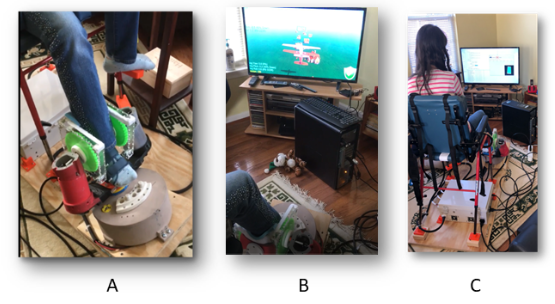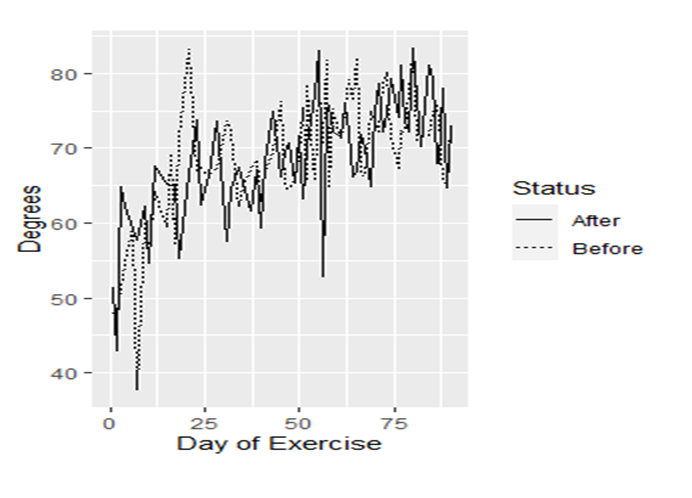Physical therapy (PT) improves walking in children with cerebral palsy (CP). However, deciding which therapies will provide the greatest benefit to any individual child, at a given developmental stage, and with what frequency and intensity is a complex process. Barriers to implementing precision therapy are many. The limited ability we have, both short-term and long-term, to measure different therapies and exercises against changes in ankle strength, flexibility, and ultimately, walking figures prominently among these barriers.

Currently, measurement tools mostly reside with the therapist in the clinic. The child with CP goes to the clinic to receive therapy. Details of therapy are recorded, and progress over time is measured. Difficulties inherent in coordinating family and clinical schedules result in unintended gaps in a child’s therapy and increase the uncertainty of understanding which therapies are working, which therapies are not working, and which therapies could be improved.
The home environment may have greater potential than the clinic to provide flexible blocks of time for a child to practice therapeutic exercise. In fact, home exercise programs (HEP) are a commonly prescribed supplement to in-clinic treatment to enhance a child’s progress toward therapy goals. In actual experience however, parents' uncertainty about how exercises should be done, conflicting motivations among family members, and other factors have kept the promise of HEP elusive.

In the image above of the original PedBotHome prototype:
A.The child's ankle movements drive in-game activity through a robotic controller.
B. A typical game, piloting an airplane through hoops.
C. Typical in-home ICP/TCP setup. A portable therapy chair is used to help align the child's body and leg for proper execution of therapeutic maneuvers while playing.
Exercise performed during interactive (therapeutic) computer play (ICP/TCP), using general market technologies such as the Nintendo Wii as well as custom engineered systems (such as PedBotHome, pictured above and currently under development in RERC project D2), has been shown to be effective for improving gait in children with CP. The PedBotHome project has also documented preliminary evidence that use of ICP/TCP in HEP reduces parental apprehension. Thus ICP/TCP may increase the attractiveness of HEP and, consequently, the feasibility of effectively extending therapy into the home. Use of computer technologies in HEP also provides the potential to leverage the large amount of information captured by these devices over time to more precisely measure how a child is carrying out therapeutic exercise and how often he or she is exercising. These data can be evalated to improve therapeutic planning and support increased effectiveness.
For a detailed discussion of ICP/TCP, see our book chapter, Interactive Computer Play in the Pursuit of Gait Optimization for Children With Cerebral Palsy: Home, VIdeo Games, and Motivation.

Feedback on Progress Toward Therapeutic Goals
One of the concerns for families who are want to integrate ICP/TCP into their home routines is knowing whether the activity is actually achieving therapy goals.In PedbotHome, the ankle robot calculates the child's ankle range-of-motion (ROM) at the beginning and end of each session. Sometimes, ROM increases and sometimes it decreases. Individual, session measures don't have a lot of meaning. For example, ROM might increase because the child's ankle became more limber from exercise and it might decrease because the child exercised to enthusiastically and became fatigued. So individual measures don't tell children how well they are doing. However, when ROM is measure over time, an up-sloping graph, such as the one below, can show the effect the child's efforts are having. Visuals such as the one above may be useful for older children who are able to understand trending over time but may not provide encouragement to younger children who aren't yet mature enough to comprehend the concept.
Feedback on Efficiency of Effort
Over the course of a PedBotHome exercise therapy session, the child with CP plays multiple prescribed games requiring the execution of pitch, yaw, or roll maneuvers (which correspond to ankle plantar/dorsiflexion, adduction/abduction, and inversion/eversion exercises). The system captures the cumulative time the child had spent practicing each maneuver (angle) and it is possible to plot each successive time increment against the child’s score in any given game.

The figure above shows the game scores (y axis) in two levels of the Spaceship Game that the child with CP earned over the course of a dozen sessions of play. The x axis shows how much time (in seconds) the child had been playing when she earned that score. When asked what the data suggested to her, the child interpreted the trace as warm up, peak performance, fall back, and finally, fatigue. This very early exploration suggests that a custom-engineered system such as PedBotHome has the capacity to provide multiple data points describing a child with CP’s trajectory of play, and that this data may hold promise for helping therapists incorporate greater precision (ex. how long the child should continue playing/practicing specific maneuvers in an individual session) into therapy prescriptions. Displays such as the the one focused on the Spaceship Game can also show the child and family the effects of exercise in real time, and help them in decision making about persisting or taking a break. Visualization of the impact of exercise as it is performed has the potential to create more effective care collaborations between families and their clinicians.
For Further Reading
Schladen MM, Cleary K, Koumpouros Y, Monfaredi R, Salvador T, Talari HF, Slagle J, Coley C, Kovelman S, Belschner J, Evans SH. Toward Evaluation of the Subjective Experience of a General Class of User-Controlled, Robot-Mediated Rehabilitation Technologies for Children with Neuromotor Disability. Informatics (MDPI). 2020;7(4):45-50. doi: 10.3390/informatics7040045. PMID: 34522643; PMCID: PMC8436173.
Schladen MM, Koumpouros Y, Lum P. 2021. Factors mediating use of advanced rehabilitation technologies in the home. In J Kalra, NJ LIghtner, and R Taiar, Eds., Advances in Human Factors and Ergonomics in Healthcare and Medical Devices: Proceedings of the AHFE 2021 Virtual Conference on Human Factors and Ergonomics in Healthcare and Medical Devices, July 25-29, 2021, USA. Springer Nature. https://doi.org/10.1007/978-3-030-80744-3_18
Schladen, MM, Koumpouros, Y, Choong, EA, Belschner, JL. 2022. Interactive computer play in the pursuit of gait optimization for children with cerebral palsy: Home, video games, and motivation. In F. Stasolla Ed. Assistive Technologies for Assessment and Recovery of Neurological Impairments. IGI Global. DOI: 10.4018/978-1-7998-7430-0.
Multimedia
TCP: Presentation & Discusssion Children's National Hospital, Washington, DC, October 20, 2021
PedBotHome User Experience
Read about PedBot-EMA - ecological momentary assessment.
